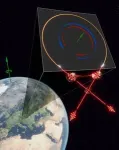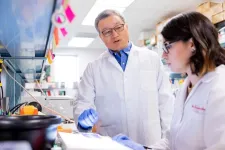(Press-News.org) KEY TAKEAWAYS
Lung cancer is the most diagnosed cancer and the leading cause of cancer death globally, representing an urgent need for new and improved treatment options.
Researchers from Brigham and Women’s Hospital developed a new nanomedicine therapy that delivers anticancer drugs to lung cancer cells and enhances the immune system's ability to fight cancer.
The research must undergo rigorous toxicology studies before moving into clinical testing in patients but represents a potential treatment for patients who have failed to respond to traditional immunotherapy.
Researchers at Brigham and Women's Hospital, a founding member of the Mass General Brigham healthcare system, have developed a new nanomedicine therapy that delivers anticancer drugs to lung cancer cells and enhances the immune system's ability to fight cancer. The team showed promising results for the new therapy in cancer cells in the lab and in mouse lung tumor models, with potential applications for improving care and outcomes for patients with tumors that have failed to respond to traditional immunotherapy. Their findings are published in Science Advances.
“Nanoparticles have been used for years to deliver targeted medication to tumor cells, while immunotherapy has also had a paradigm-shifting impact on how we treat cancer, by stopping cancer cells from evading our immune system,” said lead author Tanmoy Saha, PhD, an instructor of medicine and researcher in the Division of Engineering in Medicine at the Brigham. “Here, we’ve essentially connected these two approaches in one drug delivery system to treat non-small cell lung cancer.”
Lung cancer is the leading cause of cancer death globally, accounting for over a quarter of all cancer-related deaths. Non-small cell lung cancer (NSCLC) is the most common form, making up roughly 85 percent of all lung cancer cases. One of the popular treatment methods for NSCLC is to use immune checkpoint inhibitors, a class of drugs that block certain proteins that stop the immune system from killing cancer cells. However, most patients with NSCLC do not respond to these drugs, primarily because the treatment only targets one protein (most commonly PD-L1), and that is not abundantly expressed in most lung cancer tumors. As a result, many patients must undergo a combination of chemo and immunotherapies, resulting in enduring side effects and toxicities.
This new therapy works by bringing a nanoparticle filled with a cancer-fighting drug straight to the tumor site, while antibodies attached to the nanoparticle bind to two different proteins (CD47 and PD-L1) on cancer cells. This dual approach allows both the innate and adaptive immune systems to locate and destroy cancer cells while minimizing the toxicities commonly associated with existing cancer treatments.
“This system operates with a kind of Velcro effect. Rather than just looking for one protein on a cancer cell that the antibody can grab onto, these nanoparticles have two,” said senior author Shiladitya Sengupta, PhD, an associate professor of medicine and bioengineer in the Division of Engineering in Medicine at the Brigham. “So, if a cancer cell does not express one of the proteins that our nanoparticle targets, it can still attach to the other one, and deliver the drug loaded into the nanoparticle straight to the cancerous tissue.”
The researchers set out to find which proteins were expressed by lung tumors. They screened more than 80 human lung cancer patients’ tissue. Once the proteins were identified, they selected antibodies to target them. Next, they functionalized the antibodies with a nanoparticle that was already loaded with an anticancer drug.
Saha and his colleagues then tested the nanoparticle’s efficacy by first visualizing how well the antibodies bound to cancerous cells in the lab. They performed a series of experiments to assess and visualize the nanoparticle's binding and drug delivery capabilities. Subsequently, they tested the complex's efficacy in mouse models of two forms of lung cancer. They found that the mice’s cancer cells internalized the drug, leading to a decrease in tumor size without any major side effects or toxicities.
The study's limitations include that, so far, the therapy has only been tested on human tissue in the lab and in mouse models. It must undergo much more exhaustive toxicology studies before moving on to clinical testing. Looking ahead, the researchers hope to adapt this technology to treat other types of cancer by exploring additional antibodies and treatments that could work with this nanomedicine approach.
"While we are seeing some success with this drug delivery platform in preclinical testing, it's important to remember that mouse and human physiology are quite different. We need more studies before we can bring this concept to clinical trials, but we’re excited to see how this approach could transform cancer care," said Saha.
Authorship: In addition to Saha and Sengupta, BWH authors include Michaela Fojtů, Astha Vinay Nagar, Liya Thurakkal, Balaaji Baanupriya Srinivasan, Meghma Mukherjee, Astralina Sibiyon, Heena Aggarwal, Akash Samuel, Chinmayee Dash and HaeLin Jang.
Disclosures: Shiladitya Sengupta is a co-founder and owns equity in Vyome Therapeutics, Akamara Therapeutics, and Invictus Oncology and receives fees from Famygen and Advamedica. HaeLin Jang is a founder and has a financial interest in Curer Inc. HaeLin Jang’s interests were reviewed and are managed by Brigham and Women’s Hospital and Mass General Brigham in accordance with their conflict-of-interest policies. All other authors declare they have no competing interests.
Funding: NIH-NCI National Cancer Institute CA236702; American Lung Association, 2019A001055, 2022A016553; U.S. Army Medical Research Acquisition Activity W81XWH2210619, U.S. Army Medical Research Acquisition Activity CA201065; NIH-NCI National Cancer Institute CA276525-A1; Melanoma Research Alliance, 2022A015448
Paper cited: Saha T. et al. “Antibody nanoparticle conjugate-based targeted immunotherapy for non-small cell lung cancer.” Science Advances DOI: 10.1126/sciadv.adi2046
END
Nano-immunotherapy developed to improve lung cancer treatment
Brigham investigators have created a ‘dual action’ treatment that combines immunotherapy with targeted drug delivery and shows promise in preclinical models of lung cancer
2024-06-14
ELSE PRESS RELEASES FROM THIS DATE:
Upper surface of coastal waters can accumulate bacteria and antibiotics
2024-06-14
Atlanta, GA – June 14, 2024 – Antibiotics in the uppermost water surface, known as the sea surface microlayer, can significantly affect the number of bacteria present and contribute to the adaptation of marine bacteria against widely used antibiotics. In new research presented at ASM Microbe, scientists directly assessed the potential effects of antibiotics on bacterial diversity in Jade Bay, Southern North Sea, Germany.
The researchers tested the susceptibility and resistance of marine bacteria to ofloxacin, ...
AI enables faster, more effective antibiotic treatment of sepsis
2024-06-14
Atlanta, GA—Sepsis is a life-threatening infection complication and accounts for 1.7 million hospitalizations and 350,000 deaths annually in the U.S. Fast and accurate diagnosis is critical, as mortality risk increases up to 8% every hour without effective treatment. However, the current diagnostic standard is reliant on culture growth, which typically takes 2-3 days. Doctors may choose to administer broad-spectrum antibiotics until more information is available for an accurate diagnosis, but these can have limited efficacy and potential toxicity to the patient.
In a study presented at ASM Microbe, a team from Day Zero Diagnostics unveiled a novel approach to antimicrobial susceptibility ...
Quantum entanglement measures Earth rotation
2024-06-14
A team of researchers led by Philip Walther at the University of Vienna carried out a pioneering experiment where they measured the effect of the rotation of Earth on quantum entangled photons. The work, just published in Science Advances, represents a significant achievement that pushes the boundaries of rotation sensitivity in entanglement-based sensors, potentially setting the stage for further exploration at the intersection between quantum mechanics and general relativity.
Optical Sagnac interferometers are the most sensitive devices to rotations. They have been pivotal in our understanding of fundamental physics since the early years of the last century, contributing to establish ...
New rapid detection of bacteria in pediatric blood samples
2024-06-14
Atlanta, Ga. – June 14, 2023 – Researchers have demonstrated that a new technology could quickly and accurately diagnose bloodstream infections. The study findings were reported at ASM Microbe, the annual meeting of the American Society for Microbiology.
“There is a need to be able to rapidly and accurately diagnose bacteremia in newborn babies. They are especially susceptible to long-term morbidities and mortality the longer they go without treatment, or even with inaccurate treatment for bloodstream infections or sepsis,” said presenting study author April Aralar, Ph.D., a ...
Ex vivo gene editing and cell therapy for hereditary tyrosinemia type 1
2024-06-14
Background: We previously demonstrated the successful use of in vivo CRISPR gene editing to delete 4-hydroxyphenylpyruvate dioxygenase (HPD) to rescue mice deficient in fumarylacetoacetate hydrolase (FAH), a disorder known as hereditary tyrosinemia type 1 (HT1). The aim of this study was to develop an ex vivo gene-editing protocol and apply it as a cell therapy for HT1.
Methods: We isolated hepatocytes from wild-type (C57BL/6J) and Fah-/- mice and then used an optimized electroporation protocol to deliver Hpd-targeting CRISPR-Cas9 ribonucleoproteins into hepatocytes. Next, hepatocytes were transiently incubated in ...
Intranasal COVID-19 vaccine headed to clinical trials
2024-06-14
University of Georgia-based startup CyanVac LLC received federal funding to support a comparative Phase 2b clinical trial of CVXGA, the company’s intranasal vaccine candidates designed to protect against COVID-19.
As part of the award from Project NextGen, a federal initiative based in the U.S. Department of Health and Human Services (HHS), CyanVac will sponsor a randomized, double-blind Phase 2b study with 10,000 participants to compare the efficacy and safety of the intranasal vaccine against an FDA-approved mRNA-based COVID-19 vaccine.
The new vaccine is based on a viral delivery platform developed by He containing modified ...
High out-of-pocket costs may be barrier to filling naloxone prescriptions, study shows
2024-06-14
Patients are less likely to fill prescriptions for naloxone when they face increases in out-of-pocket costs, according to U-M researchers.
Patients are less likely to fill prescriptions for naloxone when they face increases in out-of-pocket costs, according to research by the University of Michigan.
Published in the Journal of the American Medical Association, the study utilized data from a national pharmacy transactions database from November 2020 to March 2021. Researchers found that about 1 in 3 naloxone ...
Sharks have depleted functional diversity compared to the last 66 million years
2024-06-14
New research by Swansea University and the University of Zurich has found that sharks retained high levels of functional diversity for most of the last 66 million years, before steadily declining over the last 10 million years to its lowest value in the present day.
Modern sharks are among the ocean’s most threatened species; yet have notably survived numerous environmental changes in their 250-million-year history. Today, their more than 500 species play many different ecological roles, from apex predators to nutrient transporters.
Ecological roles are determined by species’ traits such as body size, ...
Fasting primes the immune system’s natural killer cells to better fight cancer, new study in mice finds
2024-06-14
Periods of fasting reprogram the immune system’s natural killer cells to better fight cancer, according to a new study in mice from researchers at Memorial Sloan Kettering Cancer Center (MSK).
Fasting and other dietary regimens are increasingly being explored as ways to starve cancer cells of the nutrients they need to grow and to make cancer treatments more effective.
Now a team of researchers from MSK’s Sloan Kettering Institute and their collaborators have shown for the ...
Are patient partners a necessity in research?
2024-06-14
Sjögren’s disease is a systemic autoimmune disorder that often causes sicca symptoms – or dryness of the eyes and mouth, alongside many other complications such as fatigue, pain, and neurological manifestations. There are treatments that help with symptoms, but none that address the underlying disease processes.3 One key issue in developing new treatments is that Sjögren’s can differ from person to person – and that makes it hard to measure and compare outcomes in a clinical trial.
NECESSITY is an interventional trial looking at new clinical endpoints in Sjögren’s disease. ...
LAST 30 PRESS RELEASES:
New study shows how the spleen helps the immune system accept a transplant
New Mayo Clinic study advances personalized prostate cancer education with an EHR-integrated AI agent
Researchers identify novel therapeutic target to improve recovery after nerve injury
Microbes in breast milk help populate infant gut microbiomes
Reprogramming immunity to rewrite the story of Type 1 diabetes
New tool narrows the search for ideal material structures
Artificial saliva containing sugarcane protein helps protect the teeth of patients with head and neck cancer
Understanding the role of linear ubiquitination in T-tubule biogenesis
Researchers identify urban atmosphere as primary reservoir of microplastics
World’s oldest arrow poison – 60,000-year-old traces reveal early advanced hunting techniques
Bristol scientists discover early sponges were soft
New study uncovers how rice viruses manipulate plant defenses to protect insect vectors
NSF–DOE Vera C. Rubin Observatory spots record-breaking asteroid in pre-survey observations
Ribosomal engineering creates “super-probiotic” bacteria
This self-powered eye tracker harnesses energy from blinking and is as comfortable as everyday glasses
Adverse prenatal exposures linked to higher rates of mental health issues, brain changes in adolescents
Restoring mitochondria shows promise for treating chronic nerve pain
Nature study identifies a molecular switch that controls transitions between single-celled and multicellular forms
USU chemists' CRISPR discovery could lead to single diagnostic test for COVID, flu, RSV
Early hominins from Morocco reveal an African lineage near the root of Homo sapiens
Small chimps, big risks: What chimps show us about our own behavior
We finally know how the most common types of planets are created
Thirty-year risk of cardiovascular disease among healthy women according to clinical thresholds of lipoprotein(a)
Yoga for opioid withdrawal and autonomic regulation
Gene therapy ‘switch’ may offer non-addictive pain relief
Study shows your genes determine how fast your DNA mutates with age
Common brain parasite can infect your immune cells. Here's why that's probably OK
International experts connect infections and aging through cellular senescence
An AI–DFT integrated framework accelerates materials discovery and design
Twist to reshape, shift to transform: Bilayer structure enables multifunctional imaging
[Press-News.org] Nano-immunotherapy developed to improve lung cancer treatmentBrigham investigators have created a ‘dual action’ treatment that combines immunotherapy with targeted drug delivery and shows promise in preclinical models of lung cancer




